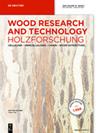建立基于近红外光谱的机器学习模型来识别木材种类
IF 1.6
3区 农林科学
Q2 FORESTRY
引用次数: 0
摘要
高效、无损的树种识别技术促进了数字林业向智能林业的过渡。虽然近红外光谱法用于木材鉴定有很好的文献记载,但化学计量学的详细机制仍不清楚。本文采用近红外光谱技术,结合6种机器学习算法(支持向量机、逻辑回归、naïve贝叶斯、k近邻、随机森林和人工神经网络)对12种木材进行了识别。最重要的是,使用孤立森林和局部异常因子来检测和排除异常值。然后从特征选择、特征提取和特征选择与特征提取相结合三个方面提出了特征工程策略来处理特征矩阵。其次,采用学习曲线法、网格搜索法和K-fold交叉验证对模型参数进行优化。最后用准确率、运行时间和混淆矩阵来评价模型的性能。当采用局部离群因子去除离群值,采用主成分分析提取特征时,基于支持向量机的树种识别模型准确率最高,达到98.24%。这些结果为构建木材自动识别系统提供了新的途径。本文章由计算机程序翻译,如有差异,请以英文原文为准。
Building machine learning models to identify wood species based on near-infrared spectroscopy
Abstract Efficient and nondestructive technology for identifying wood species facilitates the transition from digital forestry to smart forestry. While near-infrared spectroscopy applied to wood identification is well documented, the detailed mechanisms for chemometrics remain unclear. In this study, twelve wood species were identified by using near-infrared spectroscopy combined with six machine learning algorithms (support vector machine, logistic regression, naïve Bayes, k-nearest neighbors, random forest, and artificial neural network). Above all, isolated forest and local outlier factor were used to detect and exclude outliers. Then feature engineering strategies were developed from three perspectives to process feature matrices: feature selection, feature extraction, and feature selection combined with feature extraction. Next, the learning curve, grid search method, and K-fold cross-validation were used to optimize the model parameters. Finally, the accuracy, operation time, and confusion matrix were used to evaluate the model performance. When the local outlier factor was used to remove outliers and principal component analysis was used to extract features, the support-vector-machine-based wood-species identification model produced the most accurate results, with 98.24% accuracy. These results offer new avenues for constructing automatic wood-identification systems.
求助全文
通过发布文献求助,成功后即可免费获取论文全文。
去求助
来源期刊

Holzforschung
工程技术-材料科学:纸与木材
CiteScore
4.60
自引率
4.20%
发文量
83
审稿时长
3.3 months
期刊介绍:
Holzforschung is an international scholarly journal that publishes cutting-edge research on the biology, chemistry, physics and technology of wood and wood components. High quality papers about biotechnology and tree genetics are also welcome. Rated year after year as one of the top scientific journals in the category of Pulp and Paper (ISI Journal Citation Index), Holzforschung represents innovative, high quality basic and applied research. The German title reflects the journal''s origins in a long scientific tradition, but all articles are published in English to stimulate and promote cooperation between experts all over the world. Ahead-of-print publishing ensures fastest possible knowledge transfer.
 求助内容:
求助内容: 应助结果提醒方式:
应助结果提醒方式:


